Demographic profile of 266 mother-infant dyads presenting
to a multidisciplinary breastfeeding clinic: a descriptive study
By Amy S. Miller, MSc1, Joyce E. Miller, DC, PhD2, Alison M. Taylor, PhD3, Susan Way, PhD4
1. PhD student, Bournemouth University, UK
2. Associate Professor, AECC University College, Bournemouth, UK
3. Infant Feeding Lead, Bournemouth University, UK
4. Associate Professor, Bournemouth University, UK
Corresponding author: Joyce E. Miller, DC, PhD
Email: jmiller@aecc.ac.uk
Funding: Partially funded by the Seedcorn Fund, awarded by Bournemouth University, UK
The authors declare no conflict of interest.
ABSTRACT
Worldwide, sustained breastfeeding rates are lower than optimal. Mothers and infants with suboptimal breastfeeding present to a wide variety of practitioners to assist their goal of total breastfeeding. To support these mother-infant dyads, a multi-disciplinary chiropractic and midwifery feeding clinic was opened alongside a chiropractic teaching clinic in England. To improve understanding of the presentation and clinical needs of these nursing dyads, a descriptive study was developed. This paper provides an overview of the cases that presented to this clinic over nine months, with a focus on feeding difficulties, birth and musculoskeletal problems in the infant. Mothers frequently reported more than one type of feeding problem, which most commonly included difficulty attaching, painful feeding, and a one sided feeding preference. Birth intervention was more common in this population than the national averages, particularly forceps deliveries. Musculoskeletal problems were prevalent in the babies presented to the feeding clinic, most commonly of the thoracic spine, cervical spine and sternocleidomastoid. Although causation cannot be established from this type of study, intervention at birth, feeding difficulties and musculoskeletal problems frequently coexisted in these infants. Therefore, including musculoskeletal care for infants as part of support for suboptimal breastfeeding may be appropriate.
Keywords: breastfeeding, suboptimal breastfeeding, chiropractic, midwifery, interprofessional
Introduction
The importance of breastfeeding for the health of both mother and infant is widely acknowledged and supported.1 Health benefits for the infant include reduced infectious morbidity and mortality, reduced dental malocclusions and higher intelligence, when comparing longer periods of breastfeeding to those who are not breastfed or breastfed for shorter periods.1 For breastfeeding mothers, health benefits include prevention of breast cancer, improved birth spacing due to lactation amenorrhea, and possible reduction in the risk of ovarian cancer and diabetes.1 Other benefits of breastfeeding are understood in terms of prevention of costs of childhood morbidity, costs of lower cognition, and environmental costs.2 Although initiation rates are high, sustaining breastfeeding past the first days and weeks is lower than ideal in much of the world, with the United Kingdom having one of the lowest rates of sustained breastfeeding globally.2 In the United Kingdom, 69% of infants were exclusively breastfed at birth, 23% exclusively breastfed at six weeks, and 1% at six months.3 Since breastfeeding benefits are dose-dependent, an interdisciplinary breastfeeding clinic was developed, with collaboration between midwives and chiropractic providers in an educational setting. This clinic has dual purposes: 1) to help mother-infant dyads start and sustain breastfeeding; 2) to educate midwifery and chiropractic students to effectively support optimal breastfeeding for the mother and baby.
In order to better understand the population requiring this support, chiropractic students were required to complete standardized forms for each mother-infant encounter, as part of their routine record-keeping in the breastfeeding clinic. In this context, this study describes the population that attended the clinic with a view to better understand the needs of this subgroup, consisting of mothers and infants who required additional support beyond the routine professional care for suboptimal breastfeeding.
Methods
The population studied were all mother-infant dyads who entered the breastfeeding clinic after calling to make an appointment. There were no recruitment techniques. Mothers may have been told about the clinic by their health care professional, a friend or family member, or by picking up a leaflet in their local hospital or General Practitioner (GP) office. Each mother signed a consent form when enrolling her baby into the clinic, agreeing for their data to be used for research purposes. The AECC Research Ethics Subcommittee granted permission to collect this data. Data were collected between September 2015 and July 2016.
Each dyad was seen in the clinic by the multidisciplinary team. History taking and observation of a feed were completed by both midwifery and chiropractic students, each bringing their own expertise to gain understanding of the individual clinical picture. Vital signs and a musculoskeletal examination were completed by the chiropractic interns. All aspects of the clinical encounter were overseen by qualified midwives and doctors of chiropractic. Mothers were provided with information and support and babies were treated by students and doctors of chiropractic, when clinically indicated. Midwifery and chiropractic records were kept on each clinical encounter. Standardised forms were completed by the chiropractic students during each consultation and then collated as the basis for this study.
Results
A total of 266 mother-infant dyads were included in this case series over a period of nine months. All data were not available for all cases. The mean age of infants at presentation was 5.7 weeks, with a range of three days to 31 weeks; the mode age at presentation was three weeks. The mean gestational age at birth was 39.7 weeks and the mode was 40 weeks. Seventeen babies were born prematurely (31-37 weeks). There were 137 male babies (52%) and 125 female (48%). Of the 233 cases where the duration of feeding problem was reported, 64% (n = 156) were reported to have a feeding problem immediately after birth which had persisted, and 36% (n = 87) had a feeding problem which developed subsequently, up to 22 weeks later.
Birth
Ninety-one percent of babies (n = 213) were reported as a cephalic presentation, with 27% (n = 45) of these being occipito-posterior (back to back). Five percent (n = 13) were breech and the remaining 4% (n = 9) were reported as “other” (usually transverse lie).
Table 1 shows types of birth experienced by mothers presenting to the feeding clinic. More than one type of birth intervention was reported by some mothers. In this study, assisted birth was defined as any birth which had any form of intervention which changed the natural physiological process of labour and delivery, including induction, instrumental delivery and Caesarean section.
Table 1. Birth type and
interventions (n = 259)
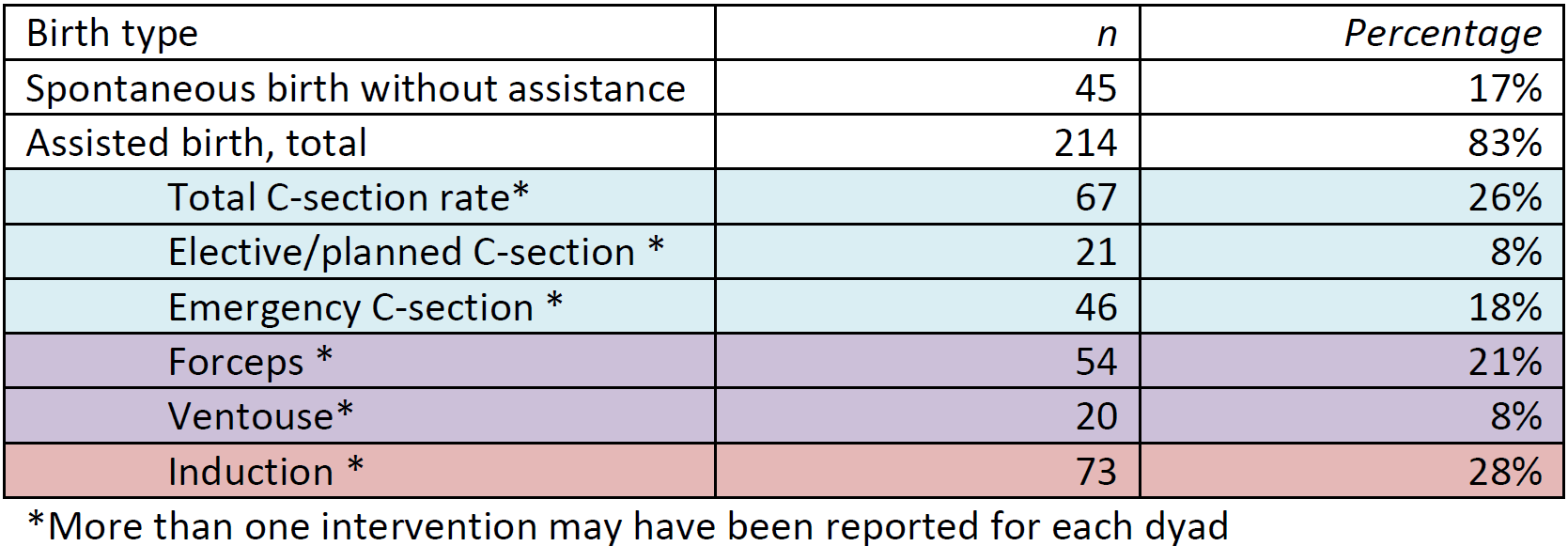
Feeding Problems
At presentation, 64% (n = 167) of babies were exclusively fed breastmilk, although not all of these babies were feeding at the breast and families were using alternative methods to feed including bottle, syringe, cup and nasogastric tube. Mixed feeding, using varying ratios of artificial milk and breast milk, was commonly used (34%; n = 90). A small number of babies (2%; n = 4) were exclusively fed artificial milk.
Mothers often reported more than one type of feeding problem (Figure 1). Specific feeding difficulties were reported by 246 mothers and included difficult attachment to the breast (54%; n = 132), breast or nipple pain (44%; n = 109), one-sided feeding preference of the baby (35%; n = 87), baby unsettled during feeds (29%; n = 72), noises from baby when feeding (21%; n = 51), mastitis (6%; n = 14), thrush (5%; n = 13), and poor/insufficient weight gain (4%; n = 10).
Figure 1. Feeding problems reported by mothers
at presentation to the Feeding Clinic
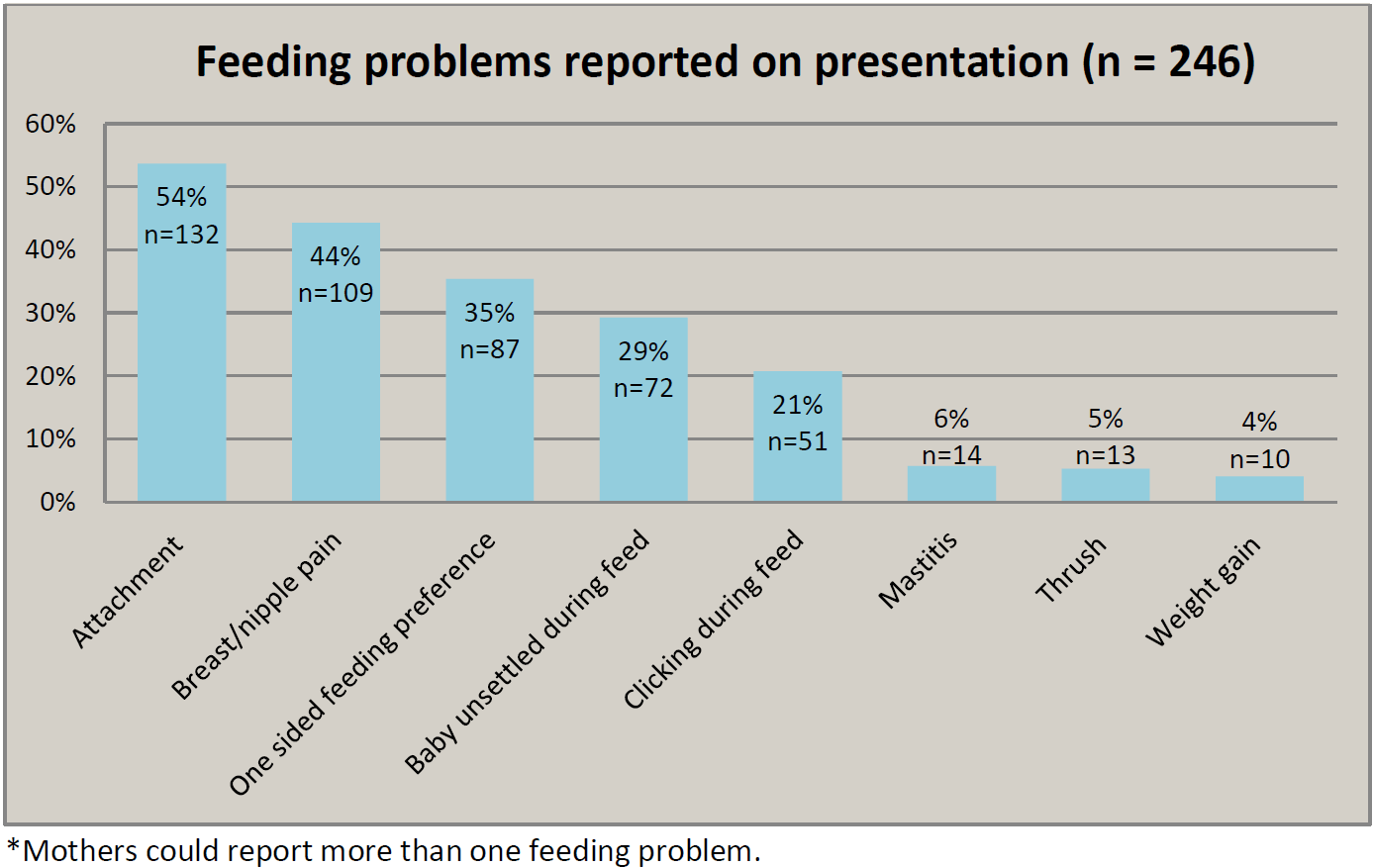
Musculoskeletal problems
Mothers pointed out postural problems in the baby: 1) that the baby could not sleep supine (43%; n = 104), 2) baby would only look to one direction (45%; n = 111), and 3) the baby’s head seemed deformed (29%; n = 68). In this sample of 266 infants, 214 infants had musculoskeletal (MSK) problems, with a total of 602 specific musculoskeletal problems identified by the chiropractic providers (Figure 2). Of the 248 mothers who were asked whether their baby had been examined and/or treated for a tongue tie, 104 (42%) of babies did not have tongue tie, 45 (18%) had been diagnosed with a tongue tie but it had not been cut, 87 (35%) had a tongue tie that had been cut and a further 12 (5%) had a tongue tie that had been cut twice or more. Thus, a total of 58% of infants in this clinic had a diagnosis of a tongue tie, either prior to presentation or identified by the chiropractic providers in the feeding clinic.
Figure 2. Area of musculoskeletal (MSK) problem in
infants as identified by chiropractors in Feeding Clinic
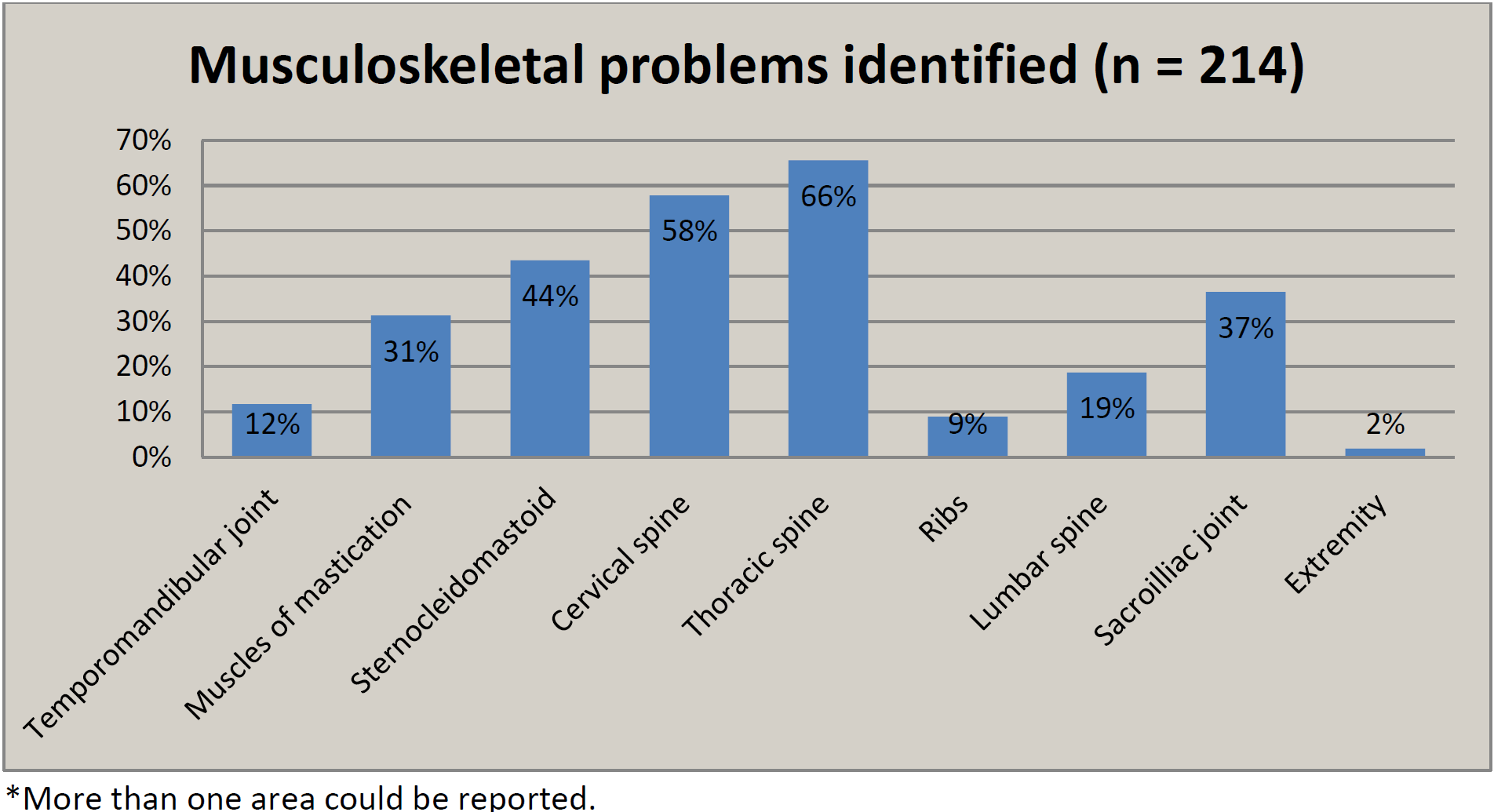
Care at the feeding clinic (Figure 3) was based on the clinical presentation, and usually included both midwifery and chiropractic care (84%; n = 223); some received care from the midwife only (14%; n = 37) or chiropractic provider only (2%; n = 6). Follow up care was reported for 135 infants (Figure 4), with 84% of those followed up at AECC clinic for musculoskeletal problems.
Figure 3. Practitioner required by
dyads
in the Feeding Clinic
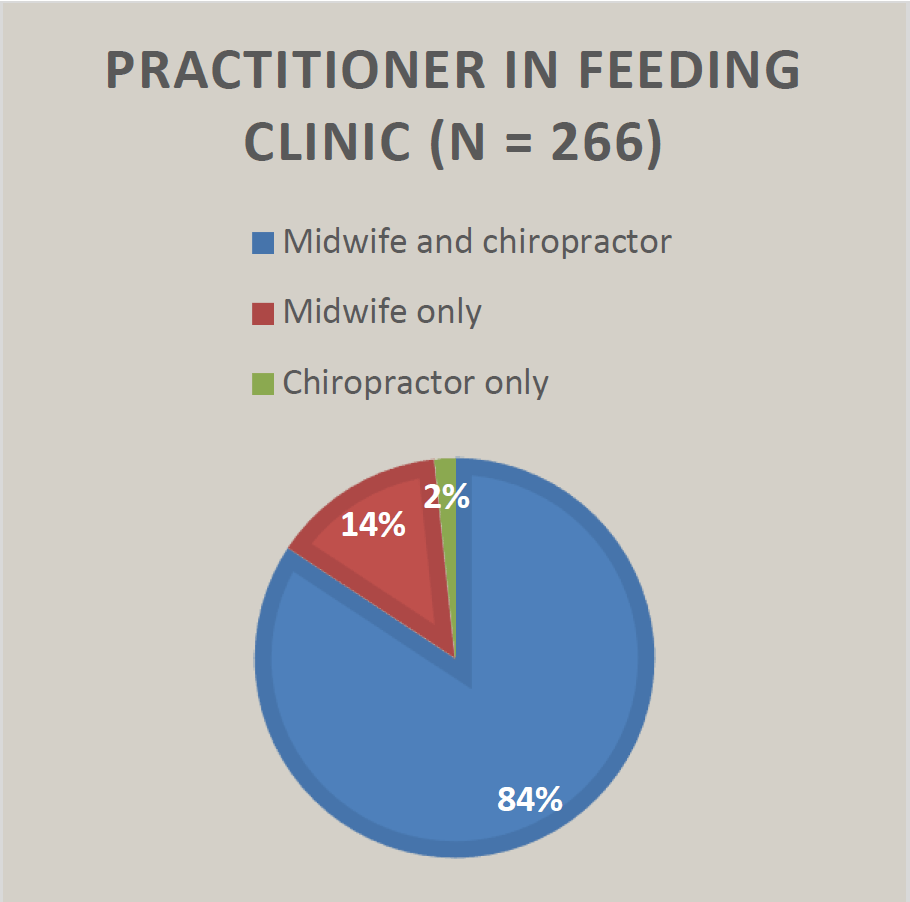
Figure 4. Follow up care after
presentation to feeding clinic
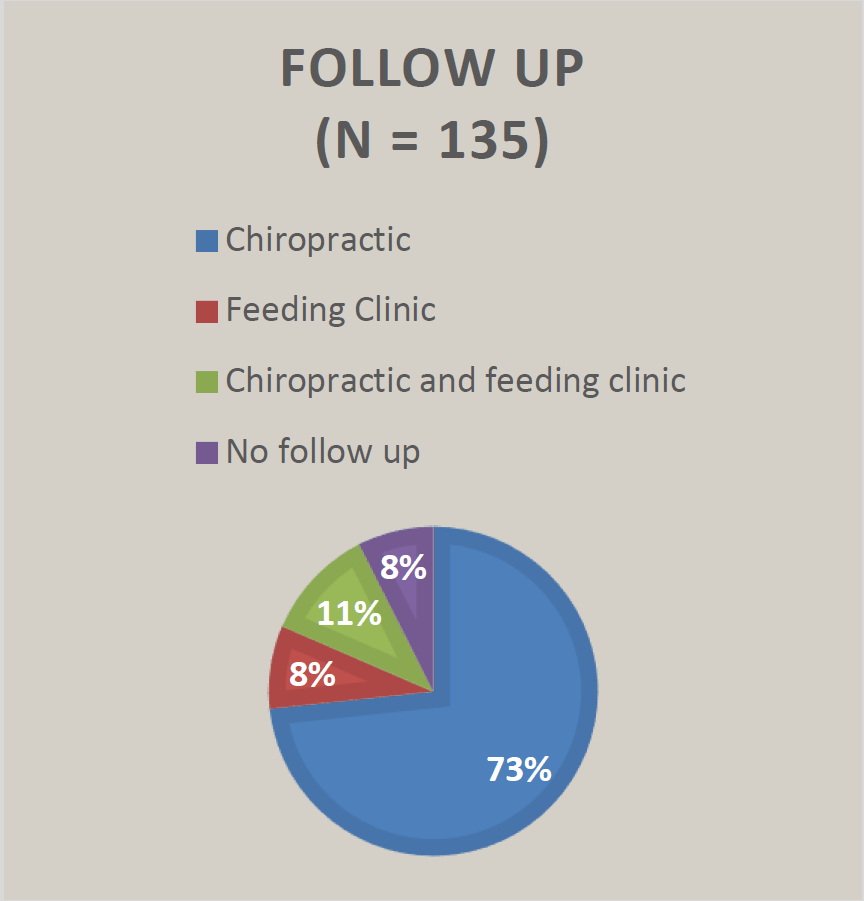
Discussion
The purpose of this study was to document the clinical presentation of mother/infant dyads attending an interdisciplinary feeding clinic staffed by midwives and chiropractic providers. Clinical notes taken during consultations were the basis of this investigation. As such, this is a case series and there was no attempt to determine the success or not of the care provided. Those findings have been reported elsewhere.4
A history of an assisted birth appears to be associated with feeding problems and this has been widely documented.5-8 Comparison of the birth interventions of babies presenting at the clinic with national statistics9 (Table 2) suggested that forceps deliveries were almost three times more common in those infants presented to the breastfeeding clinic than the national average.
Table 2. Comparison of national and
Feeding Clinic statistics for type of birth

Not all feeding problems were apparent at birth, with some dyads establishing feeding and then developing feeding problems later on. Discussion with the feeding clinic team provided ideas on several possible causes for these late developing feeding problems. The physicality of feeding a newborn with poor positioning and attachment (P&A) may be easier than feeding an older/bigger baby with continued poor P&A, when it may become unsustainable. A further suggestion was a delay in skin to skin contact and/or the initiation of breastfeeding following birth, which would normally stimulate the release of prolactin which in turn would prime the receptor cells on the lactocytes, optimising milk production in the long term.10 This results in the mother being able to provide sufficient milk in the early weeks, but as the baby grows the mother becomes unable to keep up with baby’s requirements. Finally, a minor MSK problem (e.g. from intrauterine constraint or birth) which is not alleviated by time alone may cause escalating problems. An example may be a contracture of sternocleidomastoid muscle (SCM) which may initially not affect feeding or produce a mild one-sided preference early on, but later lead to a positional head deformation and exacerbate the MSK problem leading to greater restriction, more discomfort for the baby subsequently affecting feeding.
Both parental report and MSK examination demonstrated that postural and musculoskeletal problems were common in this population. These can arise from intrauterine position or constraint and varying degrees of birth trauma.11 Whether these are directly or indirectly related to the feeding problems isn’t clear; however, assisted births are strongly associated both with feeding problems5-8 and with other postural problems in infants.11-13
Half of the infants in this population required ongoing care, most commonly in the chiropractic clinic due to musculoskeletal problems identified in the infant at the breastfeeding clinic. Chiropractors are musculoskeletalists and treat that type of problem.14,15 Many infants had MSK problems which directly affected their ability to breastfeed, such as reduced cervical extension, hypertonicity of the SCM or jaw dysfunction. However, a range of other MSK problems also presented. These included inability of the baby to lie supine, which can be a purely MSK problem and requires appropriate treatment as inability to sleep supine is an established key risk for Sudden Infant Death Syndrome (SIDS).16,17 Other postural problems reported by the parent included ability or preference of the baby to only look one direction, which is associated with development of positional head deformation (PHD)11,12 and requires treatment. Restrictions of the tissues of the neck are of particular interest in a “one-direction” baby. As the baby lies preferentially on one side of the head, a deformation develops. Although this has been termed as “merely cosmetic” by some,18,19 there is continuing evidence that there may be a link to developmental delay in some children.20-23
A key question from this data is whether these clear MSK problems (cervical spine restrictions, discomfort on supine position and head deformation) and suboptimal breastfeeding are associated, and if so, to what extent. As these are both common problems often occurring together, it may be appropriate to say there is a connection, if not causation. Vallone (2016) suggested that there is an association based on functional asymmetry of the neck.24
The relevance of tongue ties in feeding cases must also be questioned based on these current findings. Almost 40% of infants who presented to the feeding clinic had undergone a frenulotomy for a tongue tie at least once and sometimes twice, with minimal or no improvement in breastfeeding and no follow up support for breastfeeding. Whether frenulotomy was appropriate management for all of these cases must be questioned. On the other hand, when a frenulotomy did not improve breastfeeding, it reduced the likelihood of tongue tie as the underlying cause of their feeding problem. It is reasonable to consider the need for different methods of assessing tongue tie with an emphasis on function rather than appearance, along with a trial of conservative management prior to frenulotomy. This approach may be of particular relevance here, as many of the infants in this study were waiting more than two weeks to have frenulotomy provided by the National Health Service (NHS).
It appears that when a mother has difficulty breastfeeding because her baby has MSK problems or tongue tie, she will use desperate measures to adapt her feeding position in order for feeding to be more effective. This can, in turn, cause the mother to hold her baby in compromised positions that undermine effective breastfeeding.10 Arguably, using an interdisciplinary approach by assessing, supporting and treating the mother and baby together increases the chance of the mother-infant dyad to work in harmony with each other optimising breastfeeding. However, further research is required to test this hypothesis.
Limitations
This is a special population who have often sought multiple modalities of health care and a high number of health care practitioners, and thus, may not be representative of all suboptimal breastfeeding dyads. However, given the vast decline in breastfeeding rates in the first six weeks in the UK,2 and the fact that 68% of mothers in the UK National Infant Feeding Survey who stopped breastfeeding wished they could have continued,3 it may be reasonable to assume that this is not an entirely unique population. These problems may be far more common than is currently recognized and as yet are not appropriately addressed. This paper does not report on satisfaction with the care received or its benefits, if any, for the breastfeeding dyad. It does however highlight that there is a population seeking this type of care and as there is often a waiting list, it is important that further research explores the efficacy of such a service.
Conclusion
In early life and particularly with breastfeeding, rapid resolution is especially beneficial for the whole family. As MSK problems were commonly identified in this population, a multidisciplinary approach to suboptimal breastfeeding may be appropriate care for some dyads. This approach provides a wider range of expertise and broader scope of practice, allowing for several different types of suboptimal breastfeeding problems to be addressed immediately without need for onward referral and the delays this inevitably causes. This multidisciplinary approach is particularly relevant given the high incidence of musculoskeletal problems in infants with suboptimal breastfeeding.
Birth intervention was more common in this population than the national averages, particularly forceps deliveries. Musculoskeletal problems were common in the babies presented to the feeding clinic. Although causation cannot be established from this study, coexistence between intervention at birth, feeding difficulties and musculoskeletal problems was demonstrated. Further investigation into specific musculoskeletal problems and direct association with specific birth interventions and the type of feeding problem would be beneficial.
References
1. Victora CG, Bahl R, Barros AJD, França GVA, Horton S, Krasevec J, et al. Breastfeeding in the 21st century: epidemiology, mechanisms, and lifelong effect. Lancet. 2016; 387(10017):475–90.
2. Rollins NC, Bhandari N, Hajeebhoy N, Horton S, Lutter CK, Martines JC, et al. Why invest, and what it will take to improve breastfeeding practices? Lancet. 2016; 387(10017):491–504.
3. McAndrew F, Thompson J, Fellows L, Large A, Speed M, Renfrew MJ. Infant Feeding Survey 2010 [Internet]. Dundee; 2012 [cited 2017 March 6]. Available from: http://data.gov.uk/dataset/infant-feeding-survey-2010.
4. Miller J, Beharie MC, Taylor AM, Simmenes EB, Way S. Parent Reports of Exclusive Breastfeeding After Attending a Combined Midwifery and Chiropractic Feeding Clinic in the United Kingdom: A Cross-Sectional Service Evaluation. J Evid Based Complementary Altern Med. 2016;21(2):85–91.
5. Evans K., Evans R., Royal R, Westerman A., James S. Effect of caesarean section on breast milk transfer to the normal term newborn over the first week of life. Arch Dis Childhood – Fetal Neonatal Ed. 2003; 88(5):380–2.
6. Prior E, Santhakumaran S, Gale C, Philipps LH, Modi N, Hyde MJ. Breastfeeding after cesarean delivery: a systematic review and meta-analysis of world literature 1 – 3. Am J Clin Nutr. 2012;95(5):1113–35.
7. Smith LJ, Kroeger. Impact of birthing practices on breastfeeding. Boston: Jones and Bartlett Publishers; 2010.
8. Pérez-ríos N, Ramos-valencia G, Ortiz AP. Cesarean Delivery as a Barrier for Breastfeeding Initiation: The Puerto Rican Experience. J Hum Lact. 2008; 24(3):293–302.
9. Health and Social Care Information Centre. Hospital Episode Statistics: NHS Maternity Statistics – England, 2014-15 [Internet]. NHS digital. 2015. Available from: http://digital.nhs.uk/catalogue/PUB19127.
10. Pollard M. Evidence-Based Care for Breastfeeding Mothers. Abingdon: Routledge; 2012.
11. Stellwagen L, Hubbard E, Chambers C, Lyons Jones K. Torticollis, facial asymmetry and plagiocephaly in normal newborns. Arch Dis Chidhood. 2008; 93(10):827–31.
12. Wall V, Glass R. Mandibular Asymmetry and Breastfeeding Problems: Experience From 11 Cases. J Hum Lact. 2006; 22(3):328–34.
13. Smith LJ. Impact of Birthing Practices on the Breastfeeding Dyad. J Midwifery Women’s Heal. 2007; 52(6):621–30.
14. Holleman AC, Nee J, Knaap S. Chiropractic management of breast-feeding difficulties : a case report. J Chiropr Med [Internet]. National University of Health Sciences; 2011; 10(3):199–203. Available from: http://dx.doi.org/10.1016/j.jcm.2011.01.010.
15. Miller J, Miller L, Sulesund A-K, Yevtushenko A. Contribution of Chiropractic Therapy to Resolving Suboptimal Breastfeeding: A Case Series of 114 Infants. J Manipulative Physiol Ther. 2009; 32(8):670–4.
16. Gilbert R, Salanti G, Harden M, See S. Infant sleeping position and the sudden infant death syndrome: systematic review of observational studies and historical review of recommendations from 1940 to 2002. Int J Epidemiol. 2005; 34(4):874–87.
17. Lullaby Trust. The Lullaby Trust: Evidence Base [Internet]. Lullaby Trust. 2014 [cited 2016 Apr 23]. Available from: http://www.lullabytrust.org.uk/file/Evidence-Base-updated-Oct-14.pdf.
18. American Academy of Paediatrics Task Force on Infant Sleep Position and Sudden Infant Death Syndrome. Positioning and SIDS. Pediatrics. 1992; 89(6):1120-1126.
19. American Academy of Pediatrics Task Force on Sudden Infant Death Syndrome. The changing concepts of sudden infant death syndrome: Diagnostic coding shifts, controversies regarding the sleeping environment, and new variable to consider in reducing risk. Pediatrics. 2005; 116, 1245-1255.
20. Majnemer A, Barr RG. Association between sleep position and early motor development. The Journal of Pediatrics. 2006; 149 (5), 623-629. e621.
21. Collett BR, Breiger D, King D, Cunningham ML, Speltz ML. Neurodevelopmental implications of “deformational” plagiocephaly. J Dev Behav Pediatr. 2005; 26(5):379-89.
22. Hutchinson BL, Stewart AW, Mitchell EA. Characteristics, head shape measurements and developmental delay in 287 consecutive infants attending a plagiocephaly clinic. Acta Paediatr. 2009; 98(9):1494-9.
23. Speltz ML, Collett BR, Scott-Miller M, Starr JR, Heike C, Wolfram-Aduan AM, King D, Cunningham ML. Case-control study of neurodevelopment in deformational plagiocephaly. Pediatrics. 2010; 125(3):537-542.
24. Vallone S. Evaluation and treatment of breastfeeding difficulties associated with of cervicocranial dysfunction: a chiropractic perspective. Journal of Clinical Chiropractic Pediatrics. 2016; 15(3):1301-1305. |

